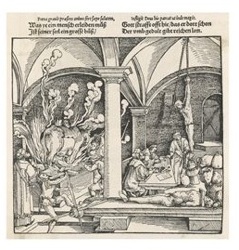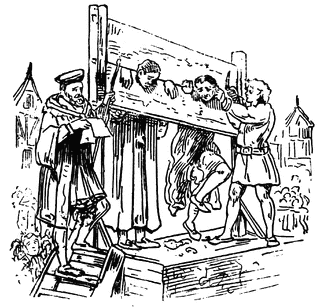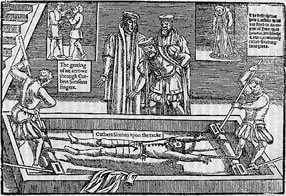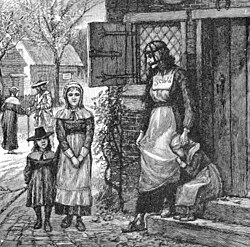Brazen Bull

When a victim is placed inside the brazen bull, he or she is slowly burned to death. This device gradually became more sophisticated until the Greek invented a complex system of tubes in order to make the victim's screams sound like an infuriated ox.
Catherine Wheel

the condemned were placed on a cart-wheel with their limbs stretched out along the spokes over two sturdy wooden beams. The wheel was made to slowly revolve, and a large hammer or an iron bar was then applied to the limb over the gap between the beams, breaking the bones. This process was repeated several times per limb. Sometimes it was 'mercifully' ordered that the executioner should strike the criminal on chest and stomach, blows known as coups de grâce (French: "blow of mercy"), which caused lethal injuries, leading to the end of the torture by death
The Heretic's Fork

One end was pushed under the chin, and the other into the sternum, the strap fixing the device to the neck. This effectively immobilized the head at a total extension of the neck, and caused great pain.
Iron Maiden

An iron maiden is usually an iron cabinet, but can be built with wood or iron. It usually has a small closable opening so that the torturer can interrogate their victim and torture or kill a person by piercing the body with sharp objects (such as knives, spikes or nails), while he or she is forced to remain standing. The condemned bleeds profusely and is weakened slowly, eventually dying because of blood loss, or perhaps asphyxiation. Most iron maidens were made so the sharp points did not pierce vital organs, thus immediately killing a person, in order to drag out the torturous death.
Judas Chair

The victim was hung by an iron belt surrounding his upper waist, he was bound hand and foot, his legs were kept slightly open by a stick in such a way that he could only move them at the same time. He was hoisted over a pointed pyramid put on top of a rack. His legs were stretched out frontwards and joined with a rope at his ankles. The victim was lowered onto the pyramid point that penetrated into the anus or vagina. Thus the victim, with his muscles contracted, couldn't relax and fall asleep.
Pillory

A prisoner in the pillory would be presumed to have committed a more serious crime and accordingly get a more angry crowd reaction. With hands trapped, he could not protect himself from anything thrown at him, either harmless items like rotten food or injurious ones, even heavy stones: blinding, permanent maiming or death could be the consequences. The criminal could also be sentenced to further punishments while in the pillory: humiliation by shaving of some or all of the hair, or regular corporal punishment(s), notably flagellation (the pillory serving as the whipping post), birching, caning or even permanent mutilation such as branding, or having an ear cut off.
Torture Rack

The rack is a torture device that consists of an oblong rectangular, usually wooden frame, slightly raised from the ground, with a roller at one, or both, ends, having at one end a fixed bar to which the legs were fastened, and at the other a movable bar to which the hands were tied. The victim's feet are fastened to one roller, and the wrists are chained to the other.
As the interrogation progresses, a handle and ratchet attached to the top roller are used to very gradually stepwise increase the tension on the chains, which induces excruciating pain as the victim's joints slowly dislocate. By means of pulleys and levers this latter could be rolled on its own axis, thus straining the ropes till the sufferer's joints were dislocated.
Scold's Bridle

A scold's bridle (also the brank or branks) was a torture device for women, resembling an iron muzzle or cage for the head with an iron curb projecting into the mouth and resting precariously atop the tongue. The curb was frequently studded with spikes so as to cruelly torture the tongue if it dared stir: lying calmly in place, it inflicted a minimum of pain.
The Pear of Anguish

The Pear of Anguish had the shape of a pear; As a handle was turned, the spoon-shaped lobes opened; increasing pain. Even though the Pear of Anguish was mostly used for oral punishments, homosexuals had it fixed in their anus and women in their vagina. Causing severe pain, after this torture was employed on the mouth; the victim's teeth would get destroyed; making blood pour out of the victim's mouth often causing death.
The Keep
Known as "The Keep", this is one of the most embarrassing and painful tortures ever designed by the human mind. A victim would be sometimes fixed with iron nails to the cage and the door would be shut forever. The small openings in "The Keep" were big enough for hungry birds to eat whatever they could. The defenseless victim, having his arms tied with a rope, had nothing better to do than to hysterically stare at the birds--and other animals--eating him alive.
Normally suited for nobles and the alike, this torture wasn't only painful; but socially speaking, it killed whatever honor a person had left. The cage would be hung on the main square--or on a church--exhibiting the victim's fate to a whole town.
After many days of agonizing and severe pain, the unlucky person would finally pass out. Sometimes the townspeople would throw stones or other objects to "awake" him.


When a victim is placed inside the brazen bull, he or she is slowly burned to death. This device gradually became more sophisticated until the Greek invented a complex system of tubes in order to make the victim's screams sound like an infuriated ox.
Catherine Wheel

the condemned were placed on a cart-wheel with their limbs stretched out along the spokes over two sturdy wooden beams. The wheel was made to slowly revolve, and a large hammer or an iron bar was then applied to the limb over the gap between the beams, breaking the bones. This process was repeated several times per limb. Sometimes it was 'mercifully' ordered that the executioner should strike the criminal on chest and stomach, blows known as coups de grâce (French: "blow of mercy"), which caused lethal injuries, leading to the end of the torture by death
The Heretic's Fork

One end was pushed under the chin, and the other into the sternum, the strap fixing the device to the neck. This effectively immobilized the head at a total extension of the neck, and caused great pain.
Iron Maiden

An iron maiden is usually an iron cabinet, but can be built with wood or iron. It usually has a small closable opening so that the torturer can interrogate their victim and torture or kill a person by piercing the body with sharp objects (such as knives, spikes or nails), while he or she is forced to remain standing. The condemned bleeds profusely and is weakened slowly, eventually dying because of blood loss, or perhaps asphyxiation. Most iron maidens were made so the sharp points did not pierce vital organs, thus immediately killing a person, in order to drag out the torturous death.
Judas Chair

The victim was hung by an iron belt surrounding his upper waist, he was bound hand and foot, his legs were kept slightly open by a stick in such a way that he could only move them at the same time. He was hoisted over a pointed pyramid put on top of a rack. His legs were stretched out frontwards and joined with a rope at his ankles. The victim was lowered onto the pyramid point that penetrated into the anus or vagina. Thus the victim, with his muscles contracted, couldn't relax and fall asleep.
Pillory

A prisoner in the pillory would be presumed to have committed a more serious crime and accordingly get a more angry crowd reaction. With hands trapped, he could not protect himself from anything thrown at him, either harmless items like rotten food or injurious ones, even heavy stones: blinding, permanent maiming or death could be the consequences. The criminal could also be sentenced to further punishments while in the pillory: humiliation by shaving of some or all of the hair, or regular corporal punishment(s), notably flagellation (the pillory serving as the whipping post), birching, caning or even permanent mutilation such as branding, or having an ear cut off.
Torture Rack

The rack is a torture device that consists of an oblong rectangular, usually wooden frame, slightly raised from the ground, with a roller at one, or both, ends, having at one end a fixed bar to which the legs were fastened, and at the other a movable bar to which the hands were tied. The victim's feet are fastened to one roller, and the wrists are chained to the other.
As the interrogation progresses, a handle and ratchet attached to the top roller are used to very gradually stepwise increase the tension on the chains, which induces excruciating pain as the victim's joints slowly dislocate. By means of pulleys and levers this latter could be rolled on its own axis, thus straining the ropes till the sufferer's joints were dislocated.
Scold's Bridle

A scold's bridle (also the brank or branks) was a torture device for women, resembling an iron muzzle or cage for the head with an iron curb projecting into the mouth and resting precariously atop the tongue. The curb was frequently studded with spikes so as to cruelly torture the tongue if it dared stir: lying calmly in place, it inflicted a minimum of pain.
The Pear of Anguish

The Pear of Anguish had the shape of a pear; As a handle was turned, the spoon-shaped lobes opened; increasing pain. Even though the Pear of Anguish was mostly used for oral punishments, homosexuals had it fixed in their anus and women in their vagina. Causing severe pain, after this torture was employed on the mouth; the victim's teeth would get destroyed; making blood pour out of the victim's mouth often causing death.
The Keep
Known as "The Keep", this is one of the most embarrassing and painful tortures ever designed by the human mind. A victim would be sometimes fixed with iron nails to the cage and the door would be shut forever. The small openings in "The Keep" were big enough for hungry birds to eat whatever they could. The defenseless victim, having his arms tied with a rope, had nothing better to do than to hysterically stare at the birds--and other animals--eating him alive.
Normally suited for nobles and the alike, this torture wasn't only painful; but socially speaking, it killed whatever honor a person had left. The cage would be hung on the main square--or on a church--exhibiting the victim's fate to a whole town.
After many days of agonizing and severe pain, the unlucky person would finally pass out. Sometimes the townspeople would throw stones or other objects to "awake" him.
Last edited by a moderator:





